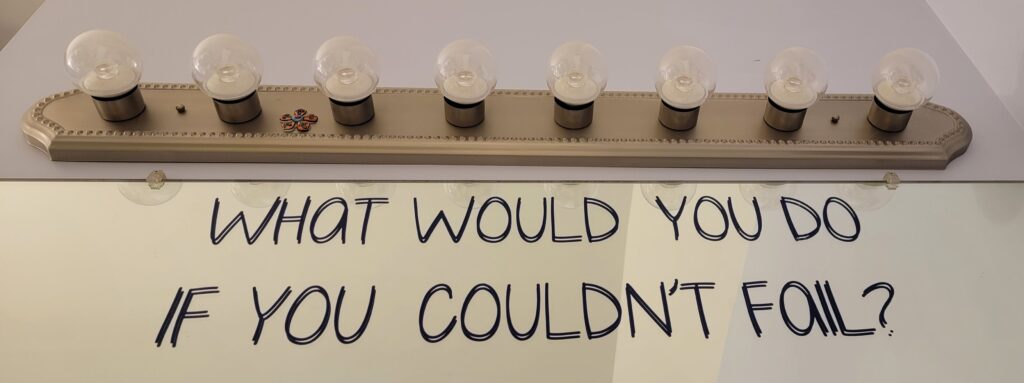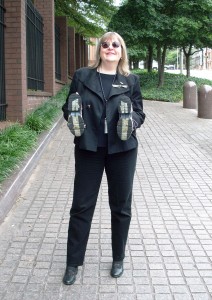What would you do if you couldn’t fail? It’s a big question, with all kinds of implications. You may see it in a self help, inspirational or life coaching context, a job interview or a Ted Talk. And, you would probably answer it differently for all those contexts.
Laura Shultz and her unexpected response to saving her grandson’s life was mentioned in the first piece I ever read on this subject. The experience made her rethink and change her life. Rethinking what’s possible can change everything. Changing everything is big enough to consider often, so I chose a font, a color and a size and went to the local vinyl shop to have them cut the words for me. For at least 4 or 5 years I’ve had that question on my bathroom mirror reminding me to think bigger and stop putting things off for my future self. I see it (whether I think about it or not) several times a day.

The Big Things
My top answer, if anything really was possible, would be the altruistic beauty queen answer tweaked by my understanding of the world, and I’d mean every world of it it. I’d say things like achieve world peace and social justice. It is the social justice, of course, that results in world peace. I’d want governance, business and manufacturing to have real truthful transparency so all interested parties could become an informed and knowledgeable invisible hand.
I’d want to achieve true economic and environmental balance and have equal access to the best healthcare and phenomenal education for all because knowledge is powerful. Physical and mental healthcare would be so good that crime and bankruptcies would be greatly reduced, virtually non existent. We would build thoughtful infrastructure planned for multi-use with wide range benefits for long term low impact sustainability everywhere. My ideas go on with more things than most people agree are good, but don’t know how to accomplish.
These are my top tier dreams. I know how lofty and nearly impossible they are. I can’t bring myself to say that they are actually impossible though because, while I don’t believe a lot of things are likely, I have to leave room for these things to be possible for our future selves, for our grandchildren and theirs. It would take 7.9 billion leaps of faith, but it could happen.
A Medium Thing
I have dreams that are still big, but more realistic too. A year or more ago a vacant school for sale reminded me how much I’d like to bring my co-op idea into being. The site didn’t have enough land to do everything I wanted to, but it had some pretty awesome potential. I sat in the parking lot and imagined a green roof and what could be done with other spaces. The location solved one of many reasons I put the idea aside. It was a reasonable commute. For family reasons it would be difficult to move to a better location right now, but I got so psyched when I saw it on the way to ride my bike from a trailhead I hadn’t been going to, and was ready to set my sights high. I spent the afternoon doing enough Googling to find out the school would be razed. There were already drawings of a chic high rent glass and steel building that would replace the school.
The sighting got me looking at the possible though. I had originally envisioned something built from the ground up, a new building in a rural area near an exit on a high traffic interstate. After I found out the building I looked at was already dead I looked for other abandoned schools or other buildings inside a commute. There were, in fact, some even better sights, with bigger prices to match. I’ve even reimagined it more recently in a trailside version with overnight capacity for cyclists. Maybe after the cycling video I’ll be more of a known entity. Maybe it could be a dream come true instead of a pipe dream. Maybe the message on my mirror is setting up house in my sub-conscious having the intended effect.
The Now Thing
Part of the point in answering the question of what you would do if you couldn’t fail is figuring out how to put your time and effort where your heart is right now instead of editing yourself for some lower level of purpose, success, or happiness while putting off joy and purpose until you feel ready.
While I’m learning not to put off my most important dreams, I also do have to work within the life I currently have. That’s where the cycling project comes in. It isn’t saving all the parts of the whole world in my next to impossible dream right now, but It is consistent with my highest ideals and within my current stretching reach.
I feel encouraged by people like Marjory Stoneman Douglass, a suffragette, who was plenty accomplished before she started Friends of the Everglades at age 79, and continued to work to preserve the River of Grass for another 29 years, stopping only when she died at 108.
I don’t know what I’ll do next, probably not something nearly so as impressive or as impactful as some of the great people I admire, but I’ll just keep making Baby Steps in the right direction.
Have a glorious day, and we’ll see you on the trail.

